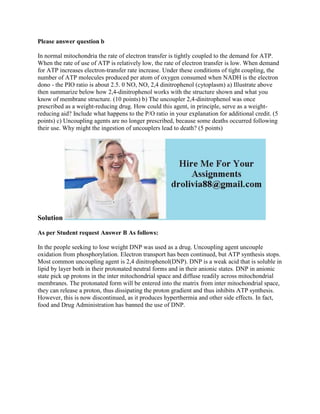Please answer question b In normal mitochondria the rate of electron t.docx
Please answer question b In normal mitochondria the rate of electron transfer is tightly coupled to the demand for ATP. When the rate of use of ATP is relatively low, the rate of electron transfer is low. When demand for ATP increases electron-transfer rate increase. Under these conditions of tight coupling, the number of ATP molecules produced per atom of oxygen consumed when NADH is the electron dono - the PIO ratio is about 2.5. 0 NO, NO, 2,4 dinitrophenol (cytoplasm) a) Illustrate above then summarize below how 2,4-dinitrophenol works with the structure shown and what you know of membrane structure. (10 points) b) The uncoupler 2,4-dinitrophenol was once prescribed as a weight-reducing drug. How could this agent, in principle, serve as a weight-reducing aid? Include what happens to the P/O ratio in your explanation for additional credit. (5 points) c) Uncoupling agents are no longer prescribed, because some deaths occurred following their use. Why might the ingestion of uncouplers lead to death? (5 points) Solution As per Student request Answer B As follows: In the people seeking to lose weight DNP was used as a drug. Uncoupling agent uncouple oxidation from phosphorylation. Electron transport has been continued, but ATP synthesis stops. Most common uncoupling agent is 2,4 dinitrophenol(DNP). DNP is a weak acid that is soluble in lipid by layer both in their protonated neutral forms and in their anionic states. DNP in anionic state pick up protons in the inter mitochondrial space and diffuse readily across mitochondrial membranes. The protonated form will be entered into the matrix from inter mitochondrial space, they can release a proton, thus dissipating the proton gradient and thus inhibits ATP synthesis. However, this is now discontinued, as it produces hyperthermia and other side effects. In fact, food and Drug Administration has banned the use of DNP. .

Recomendados
Recomendados
Más contenido relacionado
Similar a Please answer question b In normal mitochondria the rate of electron t.docx
Similar a Please answer question b In normal mitochondria the rate of electron t.docx (20)
Más de ellenj4
Más de ellenj4 (20)
Último
Último (20)
Please answer question b In normal mitochondria the rate of electron t.docx
- 1. Please answer question b In normal mitochondria the rate of electron transfer is tightly coupled to the demand for ATP. When the rate of use of ATP is relatively low, the rate of electron transfer is low. When demand for ATP increases electron-transfer rate increase. Under these conditions of tight coupling, the number of ATP molecules produced per atom of oxygen consumed when NADH is the electron dono - the PIO ratio is about 2.5. 0 NO, NO, 2,4 dinitrophenol (cytoplasm) a) Illustrate above then summarize below how 2,4-dinitrophenol works with the structure shown and what you know of membrane structure. (10 points) b) The uncoupler 2,4-dinitrophenol was once prescribed as a weight-reducing drug. How could this agent, in principle, serve as a weight- reducing aid? Include what happens to the P/O ratio in your explanation for additional credit. (5 points) c) Uncoupling agents are no longer prescribed, because some deaths occurred following their use. Why might the ingestion of uncouplers lead to death? (5 points) Solution As per Student request Answer B As follows: In the people seeking to lose weight DNP was used as a drug. Uncoupling agent uncouple oxidation from phosphorylation. Electron transport has been continued, but ATP synthesis stops. Most common uncoupling agent is 2,4 dinitrophenol(DNP). DNP is a weak acid that is soluble in lipid by layer both in their protonated neutral forms and in their anionic states. DNP in anionic state pick up protons in the inter mitochondrial space and diffuse readily across mitochondrial membranes. The protonated form will be entered into the matrix from inter mitochondrial space, they can release a proton, thus dissipating the proton gradient and thus inhibits ATP synthesis. However, this is now discontinued, as it produces hyperthermia and other side effects. In fact, food and Drug Administration has banned the use of DNP.